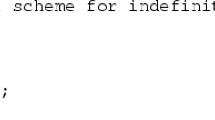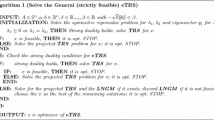Abstract
The interval bounded generalized trust region subproblem (GTRS) consists in minimizing a general quadratic objective, q 0(x)→min, subject to an upper and lower bounded general quadratic constraint, ℓ≤q 1(x)≤u. This means that there are no definiteness assumptions on either quadratic function. We first study characterizations of optimality for this implicitly convex problem under a constraint qualification and show that it can be assumed without loss of generality. We next classify the GTRS into easy case and hard case instances, and demonstrate that the upper and lower bounded general problem can be reduced to an equivalent equality constrained problem after identifying suitable generalized eigenvalues and possibly solving a sparse system. We then discuss how the Rendl-Wolkowicz algorithm proposed in Fortin and Wolkowicz (Optim. Methods Softw. 19(1):41–67, 2004) and Rendl and Wolkowicz (Math. Program. 77(2, Ser. B):273–299, 1997) can be extended to solve the resulting equality constrained problem, highlighting the connection between the GTRS and the problem of finding minimum generalized eigenvalues of a parameterized matrix pencil. Finally, we present numerical results to illustrate this algorithm at the end of the paper.





Similar content being viewed by others
Notes
Checking feasibility for GTRS is simple, see Theorem 2.1(i), below.
Note that complementary slackness can be written with a single Lagrange multiplier \(\lambda\in {\mathbb{R}}\) as follows: (q 1(x)−ℓ)λ≤0≤(u−q 1(x))λ.
EIGIFP is implemented in MATLAB and finds the minimum generalized eigenvalue and eigenvector of the matrix pair (A,B) for positive definite B. It does not involve factorization of the matrices A or B.
Comparing with |x T Bx−max{min{x T Bx,u},l}|, feaseq is less sensitive to the quantity |u−l|, the thickness of the feasible region.
Indeed, when B is structured, say, block diagonal with small blocks (size 100 by 100), the GLTR algorithm tends to terminate within 1 second for the easy case and hard case 1 instances, with high accuracy; and within a couple seconds (2 to 10) for hard case 2 instances, with moderate accuracy. In contrast, the other two codes are at most 50 % faster than the time reported in Table 2 for such B.
For consistency, we regenerate the problem instance to make sure that the instances considered in this subsection have minimizer on the lower boundary.
In all our test instances below, they all turned out to have a valid left end point t − lying in [t 0+(0.2)3,t 0+1].
We regenerate another instance if A −1 b is an interior solution.
References
Barvinok, A.: Problems of distance geometry and convex properties of quadratic maps. Discrete Comput. Geom. 13(2), 189–202 (1995)
Barvinok, A.: A remark on the rank of positive semidefinite matrices subject to affine constraints. Discrete Comput. Geom. 25(1), 23–31 (2001)
Beck, A.: Quadratic matrix programming. SIAM J. Optim. 17(4), 1224–1238 (2006)
Beck, A., Eldar, Y.C.: Strong duality in nonconvex quadratic optimization with two quadratic constraints. SIAM J. Optim. 17(3), 844–860 (2006)
Bonnans, J.F., Shapiro, A.: Perturbation Analysis of Optimization Problems. Springer Series in Operations Research. Springer, New York (2000)
Burer, S., Anstreicher, K.M.: Second-order-cone constraints for extended trust-region subproblems. SIAM J. Optim. 23(1), 432–451 (2013)
Conn, A.R., Gould, N.I.M., Toint, Ph.L.: Trust-Region Methods. Society for Industrial and Applied Mathematics (SIAM), Philadelphia (2000)
Ding, Y., Ge, D., Wolkowicz, H.: On equivalence of semidefinite relaxations for quadratic matrix programming. Math. Oper. Res. 36(1), 88–104 (2011)
Finsler, P.: Über das Vorkommen definiter und semidefiniter Formen in Scharen quadratischer Formen. Comment. Math. Helv. 9, 188–192 (1937)
Flippo, O.E., Jansen, B.: Duality and sensitivity in nonconvex quadratic optimization over an ellipsoid. Eur. J. Oper. Res. 94(1), 167–178 (1996)
Fortin, C., Wolkowicz, H.: The trust region subproblem and semidefinite programming. Optim. Methods Softw. 19(1), 41–67 (2004)
Gay, D.M.: Computing optimal locally constrained steps. SIAM J. Sci. Stat. Comput. 2, 186–197 (1981)
Gohberg, I., Lancaster, P., Rodman, L.: Matrices and Indefinite Scalar Products. Birkhauser, Basel (1983)
Golub, G.H., Ye, Q.: An inverse free preconditioned Krylov subspace method for symmetric generalized eigenvalue problems. SIAM J. Sci. Comput. 24(1), 312–334 (2002) (electronic)
Gould, N.I.M., Lucidi, S., Roma, M., Toint, Ph.L.: Solving the trust-region subproblem using the Lanczos method. SIAM J. Optim. 9(2), 504–525 (1999)
Gould, N.I.M., Robinson, D.P., Sue Thorne, H.: On solving trust-region and other regularised subproblems in optimization. Math. Program. Comput. 2(1), 21–57 (2010)
Gould, N.I.M., Toint, Ph.L.: A quadratic programming bibliography. Technical report, Rutherford Appleton Laboratory, England (2001). www.optimization-online.org/DB_HTML/2001/02/285.html
Hager, W.W.: Minimizing a quadratic over a sphere. SIAM J. Optim. 12(1), 188–208 (2001)
Hestenes, M.R., McShane, E.J.: A theorem on quadratic forms and its application in the calculus of variations. Trans. Am. Math. Soc. 47, 501–512 (1940)
Jin, Q., Fang, S.C., Xing, W.: On the global optimality of generalized trust region subproblems. Optimization 59(8), 1139–1151 (2010)
Lampe, J., Rojas, M., Sorensen, D.C., Voss, H.: Accelerating the LSTRS algorithm. SIAM J. Sci. Comput. 33(1), 175–194 (2011)
Lancaster, P., Rodman, L.: Canonical forms for Hermitian matrix pairs under strict equivalence and congruence. SIAM Rev. 47(3), 407–443 (2005)
Luo, Z.-Q., Zhang, S.: On extensions of the Frank-Wolfe theorems. Comput. Optim. Appl. 13(1–3), 87–110 (1999). Computational optimization—a tribute to Olvi Mangasarian, Part II
Moré, J.J.: Generalizations of the trust region problem. Optim. Methods Softw. 2, 189–209 (1993)
Moré, J.J., Sorensen, D.C.: Computing a trust region step. SIAM J. Sci. Stat. Comput. 4, 553–572 (1983)
Parlett, B.N.: The Symmetric Eigenvalue Problem. Society for Industrial and Applied Mathematics (SIAM), Philadelphia (1998). Corrected reprint of the 1980 original
Pataki, G.: On the rank of extreme matrices in semidefinite programs and the multiplicity of optimal eigenvalues. Math. Oper. Res. 23(2), 339–358 (1998)
Pólik, I., Terlaky, T.: A survey of the S-lemma. SIAM Rev. 49(3), 371–418 (2007) (electronic)
Rendl, F., Wolkowicz, H.: A semidefinite framework for trust region subproblems with applications to large scale minimization. Math. Program. 77(2, Ser. B), 273–299 (1997)
Rockafellar, R.T.: Convex Analysis. Princeton Landmarks in Mathematics. Princeton University Press, Princeton (1997). Reprint of the 1970 original, Princeton Paperbacks
Rojas, M., Santos, S.A., Sorensen, D.C.: A new matrix-free algorithm for the large-scale trust-region subproblem. SIAM J. Optim. 11(3), 611–646 (2000)
Rojas, M., Santos, S.A., Sorensen, D.C.: Algorithm 873: LSTRS: MATLAB software for large-scale trust-region subproblems and regularization. ACM Trans. Math. Softw. 34(2), Art11, 28 (2008)
Sorensen, D.C.: Minimization of a large-scale quadratic function subject to a spherical constraint. SIAM J. Optim. 7(1), 141–161 (1997)
Stern, R., Wolkowicz, H.: Indefinite trust region subproblems and nonsymmetric eigenvalue perturbations. SIAM J. Optim. 5(2), 286–313 (1995)
Tao, P.D., An, L.T.H.: Difference of convex functions optimization algorithms (DCA) for globally minimizing nonconvex quadratic forms on Euclidean balls and spheres. Oper. Res. Lett. 19(5), 207–216 (1996)
Yakubovich, V.A.: The S-procedure in nonlinear control theory. Vestn. Leningr. Univ. 4, 73–93 (1977). English Translation, original Russian publication in Vestn. Leningr. Univ., Ser. Math. 62–77 (1971)
Ye, Y., Zhang, S.: New results on quadratic minimization. SIAM J. Optim. 14(1), 245–267 (2003) (electronic)
Acknowledgements
The first author would like to thank Nicholas I.M. Gould for his help concerning the GLTR algorithm and for providing the pre-release version of the software.
Author information
Authors and Affiliations
Corresponding author
Additional information
T.K. Pong research supported by AFOSR.
H. Wolkowicz research supported by The Natural Sciences and Engineering Research Council of Canada and by AFOSR.
Appendix: Proof of Theorem 2.1(ii)
Appendix: Proof of Theorem 2.1(ii)
Proposition A.1
Suppose that b=0 and Items 1, 2 and 3 of Assumption 2.1 are satisfied. If GTRS (1.1) is bounded below, then D-GTRS (2.2) is feasible.
Proof
We first consider the case when B is positive semidefinite. Then there exists an invertible matrix P such that
Thus, after a change of variables y=P T x, GTRS (1.1) can be equivalently written as
where
By our assumptions, the program (A.1) is bounded below. Since
and the constraint does not involve y 1, we must have
Notice that u>0 since the RICQ (2.6) holds. Hence, the second relation in (A.3) implies
By (A.3), (A.4) and a consideration of the Schur complement, we conclude that for all sufficiently large λ>0, \(\bar{A}_{3}+\lambda I \succ0\) and
Moreover, from (A.4), we see that, for all sufficiently large λ>0,
and hence \(\bar{a}_{1}\in \operatorname{{Range}}(\bar{A}_{1} - \bar{A}_{2}^{T}[\bar{A}_{3}+\lambda I]^{-1}\bar{A}_{2})\). Thus, for sufficiently large λ>0, the system of equations
is consistent. Since
and
we see from the consistency of (A.6) that  for sufficiently large λ>0. From the definition of \(\bar{a}\) and \(\bar{A}\) in (A.2), we obtain immediately that \(a\in \operatorname{{Range}}(A + \lambda B)\) for sufficiently large λ>0. This together with (A.5) proves that D-GTRS is feasible.
for sufficiently large λ>0. From the definition of \(\bar{a}\) and \(\bar{A}\) in (A.2), we obtain immediately that \(a\in \operatorname{{Range}}(A + \lambda B)\) for sufficiently large λ>0. This together with (A.5) proves that D-GTRS is feasible.
The case when B is negative semidefinite can be tackled similarly.
Next, we consider the case when B is indefinite. Suppose to the contrary that D-GTRS is infeasible. Then either A−λB is not positive semidefinite for any \(\lambda\in {\mathbb{R}}\), or there exists λ with A−λB⪰0 but all such λ satisfy \(a\notin \operatorname{{Range}}(A - \lambda B)\).
Case 1:
A−λB is not positive semidefinite for all \(\lambda\in {\mathbb{R}}\). By [24, Theorem 2.3], there exists u ∗ satisfying u ∗ T Au ∗<0 and u ∗ T Bu ∗=0.
Fix any s∈[ℓ,u]. For the above u ∗ and each t>0, we would like to find a solution x t of (x+tu ∗)T B(x+tu ∗)=s that is uniformly bounded in t. For s=0, we just take x t =0. In the case when s>0, the x we seek has to satisfy
Let B=PDP T for some orthogonal matrix P and diagonal matrix D, and let β i denote the ith diagonal entry of D. Also, let \(\tilde{u}^{*}\) denote P T u ∗. Since B is indefinite, there exists an index i 0 such that \(\beta_{i_{0}}>0\). Consider the quadratic equation
It is clear that the solutions of the above quadratic equation are
Moreover, it is easy to see that \(r^{1}_{t}\) is uniformly bounded for t>0 when \(\tilde{u}^{*}_{i_{0}}\ge0\), while \(r^{2}_{t}\) is uniformly bounded for t>0 when \(\tilde{u}^{*}_{i_{0}}\le0\). Define
where \(e_{i_{0}}\) is the vector which is one at the i 0th entry and is zero otherwise. Then {x t } is uniformly bounded in t>0 and satisfies \(x_{t}^{T}Bx_{t} + 2tx_{t}^{T}Bu^{*}=s\). The case when s<0 can be considered similarly, by picking the index such that β i <0.
Next, since {x t } is bounded for t>0 and u ∗ T Au ∗<0, we see that
as t→∞. This together with the feasibility of x t +tu ∗ for all t>0 contradicts the boundedness of GTRS.
Case 2:
There exists λ with A−λB⪰0 but all such λ satisfy \(a\notin \operatorname{{Range}}(A - \lambda B)\). In this case, we apply [4, Theorem A.2] to derive a contradiction. To this end, let s∈[ℓ,u] be such that the set {x: x T Bx=s} is nonempty. Then, by assumption, we see that the equality constrained GTRS (3.1), with this s, is bounded below. Thus, f 2(x):=x T Ax−2a T x−L is nonnegative on the set {x: f 1(x)=0}, where L is a lower bound of the optimal value of the equality constrained GTRS, and f 1(x):=x T Bx−s. Furthermore, since B is indefinite, there exist x 1, x 2 such that
Using these and invoking [4, Theorem A.2], we conclude that there exists μ such that
From Schur complement, this implies that A−μB⪰0 and \(a\in \operatorname{{Range}}(A - \mu B)\). Thus, D-GTRS is feasible, a contradiction to our assumption.
Combining Cases 1 and 2, we conclude that D-GTRS is also feasible when B is indefinite. □
Rights and permissions
About this article
Cite this article
Pong, T.K., Wolkowicz, H. The generalized trust region subproblem. Comput Optim Appl 58, 273–322 (2014). https://doi.org/10.1007/s10589-013-9635-7
Received:
Published:
Issue Date:
DOI: https://doi.org/10.1007/s10589-013-9635-7




